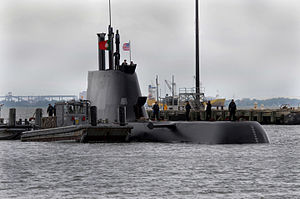Virgen-class submarine
This article is incomplete because it is pending further input from participants, or it is a work-in-progress by one author. Please comment on this article's talk page to share your input, comments and questions. Note: To contribute to this article, you may need to seek help from the author(s) of this page. |

| |
| Class overview | |
|---|---|
| Builders: | Arana Industria |
| Operators: |
|
| Cost: | |
| Built: | 2004–2023 |
| In commission: | 2006–present |
| Planned: | 18 |
| Completed: | 18 |
| Active: | 18 |
| General characteristics | |
| Type: | Attack submarine |
| Speed: |
|
| Range: | 22,000 km (11,879 nmi; 13,670 mi) at 8 kn (15 km/h; 9 mph) |
| Endurance: | 42 days underwater, without snorkeling |
| Test depth: | 350 m (1,148 ft) |
| Armament: |
|
The Virgen-class are a class of diesel–electric attack submarines built by Arana Industria for the Carlosian Navy. Construction began in 2004 with the flagship, CN Virgen (SSI-587), and concluded with CN Eloriaga (SSI-605) in 2023. The first boats entered service in 2006. It is primarily designed for operations near the Carlosian mainland. Complementing the larger, nuclear-powered Mendata-class, they are equipped with diesel engines, as well as an air-independent propulsion (AIP) system utilising polymer-electrolyte membrane (PEM) compressed hydrogen fuel cells. This allows boats of the class to operate at high speeds under diesel power, or cruise silently at low-speed using the AIP system. It can stay underwater without snorkeling for six weeks. Combined with its non-magnetic negligible exhaust emissions and lack of moving parts in an AIP system, it is incredibly stealthy.
In 2024 the Carlosian Navy expressed interest in ordering a second block of Virgen-class submarines, citing increased tensions in the Musgorocian Ocean.
Design
Armament
Primary armament of the Virgen-class consists of six 533 mm torpedo tubes. While first and foremost designed to fire R485 Orca heavyweight torpedoes, it can deploy a wide variety of other weapons as well. These include missiles such as the subsonic S774 Rábiar cruise missile, S818 Arpón anti-submarine missile and S783 Atún and S801 Éate anti-ship missiles. Altogether, it has storage for a combination of 22 torpedoes or missiles, or alternatively 44 R914 Fugu naval influence mines.
In addition to its torpedo tubes, the Virgen-class are equipped with a sail-mounted, retractable 4-tube MANPADS launcher for R59 Maris surface-to-air missiles. There is additional storage for four more missiles, for a total of eight per submarine. The variant used is the R59E, an extended range version of the standard-issue missile which allows it to engage anti-submarine helicopters and maritime patrol aircraft out to 8 km, with an operational flight ceiling of 4 km. Targets may be identified and engaged using a mast-mounted electro-optical and infrared (EO/IR) camera system, which allows the missiles to be fired remotely by the operator and without the submarine having to surface. Whilst regarded as a significant improvement over previous attempts at submarine air-defence, it is considered a weapon of last resort as it still makes the boat vulnerable to detection and enemy fire. A more capable torpedo-launched surface-to-air missile is currently being developed to replace it.